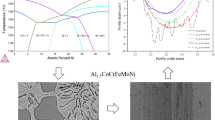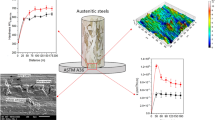Abstract
Electron microscopy, X-ray diffraction, tensile tests, and measurements of internal friction (IF) have been used to study the transformation of the structure and properties of commercial Grade-4 titanium subjected to deformation using equal-channel angular pressing combined with the Conform process (ECAP-Conform), drawing, and subsequent annealing. It has been found that the ECAP-CONFORM with drawing leads to a decrease in the grain size of titanium to about 150 nm. During annealing at 400°C for 1 h, the growth of separate grains was observed; with an increase in the annealing temperature to 450°C or higher, the growth of grains in the whole volume of a specimen occurred. It has been shown that titanium in the ultrafine-grained (UFG) state is characterized by an internal-friction peak at temperatures of 450–500°C (under the selected measurement conditions), which results from the processes of recovery and recrystallization. During repeated heating, no such effect was observed. At higher temperatures, a thermally activated relaxation internal-friction peak was found, which appears to be a grain-boundary internal-friction peak.
Similar content being viewed by others
References
R. Z. Valiev and I. V. Aleksandrov, Bulk Nanostructured Metallic Materials (AkademKniga, Moscow, 2007) [in Russian].
R. Z. Valiev, Y. Estrin, Z. Horita, T. G. Langdon, M. J. Zehetbauer, and Y. T. Zhu, “Producing bulk ultrafine-grained materials by severe plastic deformation,” JOM 58(4), 33–39 (2006).
A. I. Igolkin, “Titanium in medicine,” Titan, No. 1, 86–90 (1993).
V. V. Stolyarov, Y. T. Zhu, I. V. Alexandrov, T. C. Lowe, and R. Z. Valiev, “Influence of ECAP routes on the microstructure and properties of pure Ti,” Mater. Sci. Eng. A 299, 59–67 (2001).
A. V. Sergueeva, V. V. Stolyarov, R. Z. Valiev, and A. K. Mukherjee, “Advanced mechanical properties of pure titanium with ultrafine grained structure,” Scr. Mater., 45, 747–752 (2001).
A. A. Popov, I. Yu. Pyshmintsev, S. L. Demakov, A. G. Illarionov, T. C. Lowe, and R. Z. Valiev, “Structural and mechanical properties of nanocrystalline titanium processed by severe deformation processing,” Scr. Mater., 37, 1089–1094 (1997).
R. Z. Valiev, I. P. Semenova, V. V. Latysh, A. V. Shcherbakov, and E. B. Yakushina, “Nanostructured titanium for biomedical applications: New developments and challenges for commercialization,” Nanotechnologies in Russia, 3, 593–601 (2008).
G. A. Salishchev, S. V. Zherebtsov, and R. M. Galeyev, “Evolution of microstructure and mechanical behavior of titanium during warm multiple deformation,” Proc. TMS 2002 Ann. Meeting “Ultrafine Grained Materials II”, Ed. by T. Zhu, T. E. Langdon, R. S. Mishra, S. L. Semiatin, M. J. Saran, and T. C. Lowe (The Minerals, Metals and Materials Society, Warrendale, Pa., 2002), pp. 123–131.
S. Yu. Mironov, G. A. Salishchev, and M. M. Myshlyaev, “Structure evolution in submicrocrystalline titanium upon cold deformation,” Phys. Met. Metallogr. 93, 362–373 (2002).
O. A. Kashin, “Deformation behavior in the field of microplastic deformation of titanium and Ti-Al-V alloy with ultrafine-grained structure and different types of thermal-force impact,” Doctoral (Eng.) Dissertation, Tomsk, 2007.
G. A. Salishchev, R. M. Galeev, S. P. Malysheva, S. B. Mikhailov, and M. M. Myshlyaev, “Effect of annealing on damping and elasticity of submicrocrystalline titanium and its VT8 alloy,” Phys. Met. Metallogr. 87, 313–317 (1999).
I. S. Golovin, T. S. Pavlova, S. B. Golovina, H. -R. Sinning, and S. A. Golovin, “Effect of severe plastic deformation of Fe-26 at. % Al and titanium on internal friction,” Mater. Sci. Eng. A 442, 165–169 (2006).
G. I. Raab, R. Z. Valiev, D. V. Gunderov, T. Lowe, A. Misra, and Yu. Zhu, “Long-length ultrafine-grained titanium rods produced by ECAP-conform,” Mater. Sci. Forum 584–586, 80–88 (2008).
G. I. Raab, A. V. Polyakov, D. V. Gunderov, and R. Z. Valiev, “Formation of a nanostructure and properties of titanium rods during equal-channel angular pressing CONFORM followed by drawing,” Russ. Metall. (Metally), No. 5, 416–420 (2009).
I. S. Golovin, “Grain-boundary relaxation in copper before and after equal-channel angular pressing and recrystallization,” Phys. Met. Metallogr. 110, 405–412 (2010).
I. S. Golovin and Y. Estrin, “Mechanical spectroscopy of ultrafine grained copper,” Mater. Sci. Forum 667–669, 857–862 (2011).
G. D. Fan, M. Y. Zheng, X. S. Hu, C. Xu, K. Wu, and I. S. Golovin, “Improved mechanical property and internal friction of pure Mg processed by ECAP,” Mater. Sci. Eng., A 556, 588–594 (2012).
R. Kohlrausch, “Theorie des elektrischen Ruckstandes in der Leidener Flasche,” Ann. Phys. Chem. (Poggendorf), 91, 179–214 (1854).
A. V. Mikhaylovskaya, M. A. Ryazantseva, I. S. Golovin, and V. K. Portnoi, “Effect of microadditions of magnesium and zinc in aluminum upon heating of cold-rolled sheets,” Phys. Met. Metallogr. 113, 795–802 (2012).
I. S. Golovin, Internal Friction and Mechanical Spectroscopy of Metallic Materials. A Tutorial (Mosk. Inst. Stali Splavov, Moscow, 2012) [In Russian].
T. Ungar, “Microstructural parameters from X-ray diffraction peak broadening,” Scr. Mater. 51, 777–781 (2004).
M. S. Blanter, I. S. Golovin, H. Neuhauser, and H.-R. Sinning, Internal Friction in Metallic Materials. AHandbook (Springer-Verlag, New York, 2007).
K. L. Ngai, A. K. Jonscher, and C. T. White, “On the origin of the universal dielectric response in condensed matter,” Nature 277(5693), 185–189 (1979).
Q. P. Kong, W. B. Jiang, Y. Shi, P. Cui, Q. F. Fang, and M. Winning, “Grain boundary internal friction in bicrystals with different misorientations,” Mater. Sci. Eng., A 521–522, 128–133 (2009).
E. F. Dudarev, G. P. Pochivalova, Yu. R. Kolobov, O. A. Kashin, I. G. Galkina, N. V. Girsova, and R. Z. Valiev, “True grain-boundary slipping in coarse- and ultrafine-grained titanium,” Russ. Phys. J. 47, 617–625 (2004).
Author information
Authors and Affiliations
Corresponding author
Additional information
Original Russian Text © D.V. Gunderov, A.V. Polyakov, V.D. Sitdikov, A.A. Churakova, I.S. Golovin, 2013, published in Fizika Metallov i Metallovedenie, 2013, Vol. 114, No. 12, pp. 1136–1143.
Rights and permissions
About this article
Cite this article
Gunderov, D.V., Polyakov, A.V., Sitdikov, V.D. et al. Internal friction and evolution of ultrafine-grained structure during annealing of Grade-4 titanium subjected to severe plastic deformation. Phys. Metals Metallogr. 114, 1078–1085 (2013). https://doi.org/10.1134/S0031918X13120041
Received:
Accepted:
Published:
Issue Date:
DOI: https://doi.org/10.1134/S0031918X13120041




